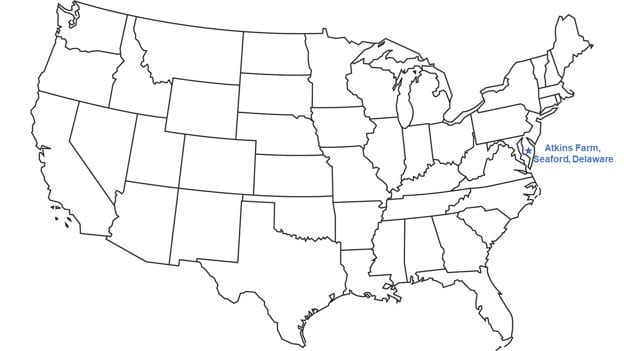Our weather has been very unpredictable, and planting is progressing slowly. 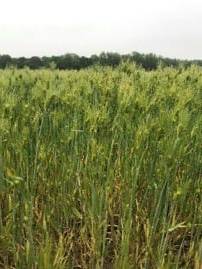
We had frost the second weekend in May, which caused some damage to the winter barley and winter wheat that already had headed out, or started producing seeds on the main stalk that forms the “head” of grain. The following weekend we had temperatures in the 80 to 90°F range, or between 26 and 32°C. That’s like a full year in one week.
We’ve also had sporadic rain on some days, and high winds on other days. Weather has made it challenging to be in my fields consistently. My heavier soils were still a bit wet when I planted. As time goes on, soil conditions have been better for planting into the lighter, sandier soils. Despite less-than-ideal soil conditions, I finished planting my soybeans on May 12, and started planting corn the following day.
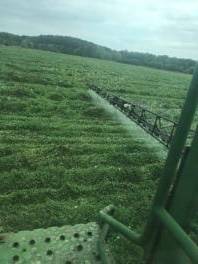 Within a few days of planting a field, I spray the cover crop with glyphosate or a mix of glyphosate and dicamba to desiccate it. That leaves the vegetation on top of the field to control weeds as the crop emerges and add organic matter over time. However, I can only spray on calm days with very little wind. Fortunately, I was able to spray most of my soybean fields the day after I finished planting them. In my corn fields, I plan an early post-emergence residual herbicide application when the crop is 15 to 20 cm, or 6 to 8 inches, tall. The cover crops give me 2 or 3 weeks of weed control right after planting, so the residual weed control lasts longer into the season.
Within a few days of planting a field, I spray the cover crop with glyphosate or a mix of glyphosate and dicamba to desiccate it. That leaves the vegetation on top of the field to control weeds as the crop emerges and add organic matter over time. However, I can only spray on calm days with very little wind. Fortunately, I was able to spray most of my soybean fields the day after I finished planting them. In my corn fields, I plan an early post-emergence residual herbicide application when the crop is 15 to 20 cm, or 6 to 8 inches, tall. The cover crops give me 2 or 3 weeks of weed control right after planting, so the residual weed control lasts longer into the season.
Corn planting may go slowly because of predicted rains and my vegetable crops. This year, I have a contract to raise lima beans and pickling cucumbers.
The company I grow lima beans for is planning their harvest schedule now. They will call me and tell me what day they want 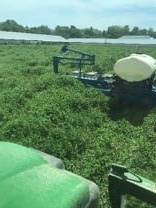 me to plant. If I am still planting corn, I have to quickly clean out and switch the planter and sprayer. Lima beans are similar to soybeans, and I plant them into my green cover crops. However, I have to burn down the cover crop quickly, before the lima beans emerge. Although this can be a challenge, I try to be accommodating because I have worked for a vegetable company in the past and understand how they need to manage their season.
me to plant. If I am still planting corn, I have to quickly clean out and switch the planter and sprayer. Lima beans are similar to soybeans, and I plant them into my green cover crops. However, I have to burn down the cover crop quickly, before the lima beans emerge. Although this can be a challenge, I try to be accommodating because I have worked for a vegetable company in the past and understand how they need to manage their season.
The cucumbers that are raised to be processed into pickles have more flexibility. The company I contract with actually plants and sprays the crop themselves. I just have to prepare the fields for them. Cucumbers have to be planted into be planted into a smooth, weed-free conventional field, so I have already chiseled and disked that ground. As long as weeds don’t emerge in those fields before they plant, I am ready for them to plant, which could be any time now that temperatures are warmer.
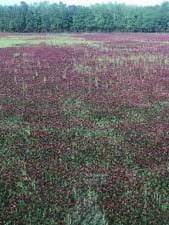 My seed business also takes quite a bit of time right now. Many of my customers planted their corn first, and they are finishing that and asking me to deliver their soybeans. And, I help them work through any problems with their seed orders. These requests frequently pull me out of my own tractor, which also slows me down. I often end up planting late into the night when the weather allows so that I keep making progress on my own fields while supporting my customers.
My seed business also takes quite a bit of time right now. Many of my customers planted their corn first, and they are finishing that and asking me to deliver their soybeans. And, I help them work through any problems with their seed orders. These requests frequently pull me out of my own tractor, which also slows me down. I often end up planting late into the night when the weather allows so that I keep making progress on my own fields while supporting my customers.
The COVID-19 threat is still very real, although we are anxious to figure out a new normal. So as I help my seed customers, I am social distancing. I just drop off seed and wave. I don’t ask them to sign invoices in person. And, I don’t ride along in tractors as they plant to see how it’s going and offer recommendations, which is something I usually enjoy.
So though it’s slow, I am making progress this spring.
